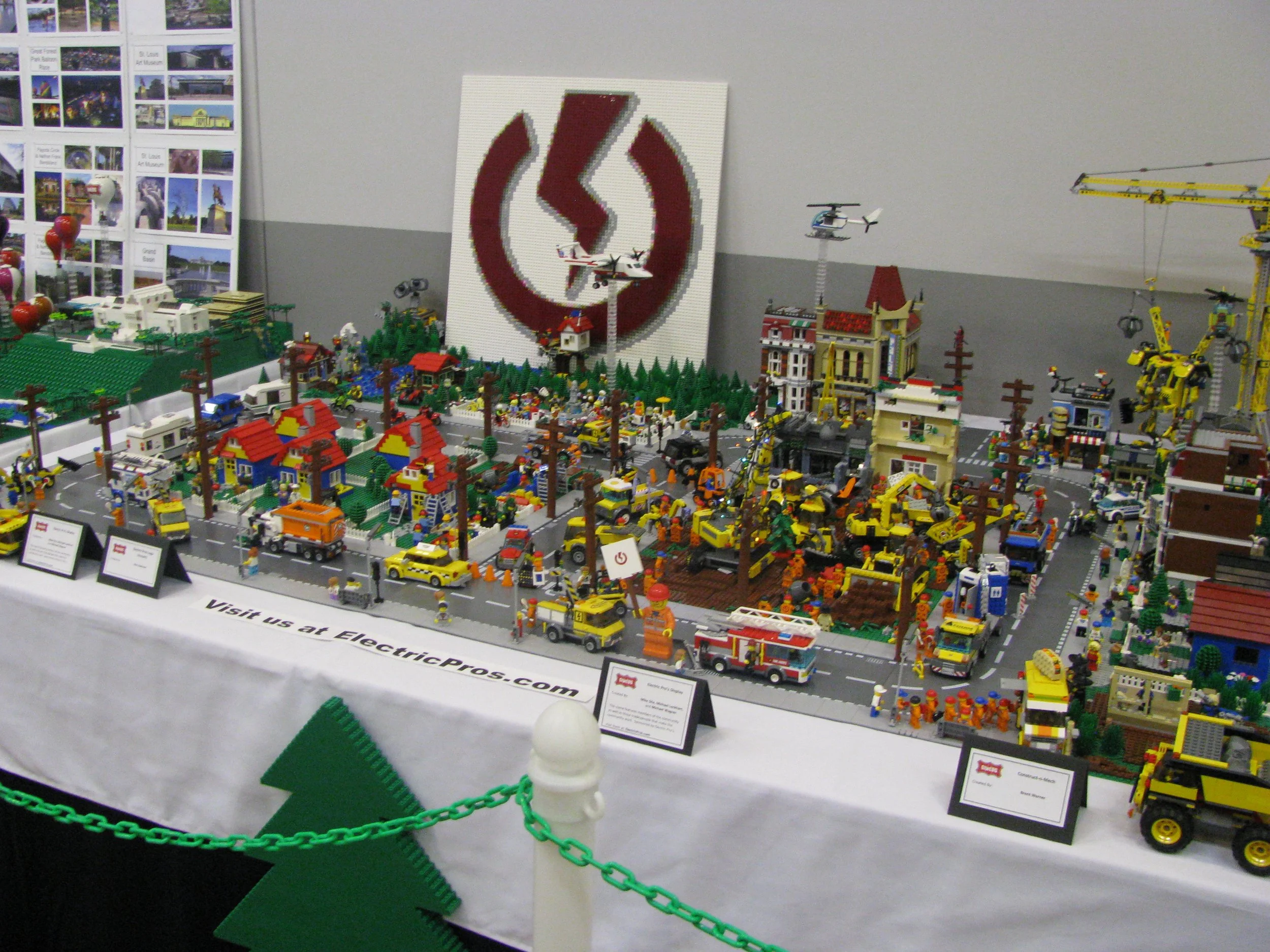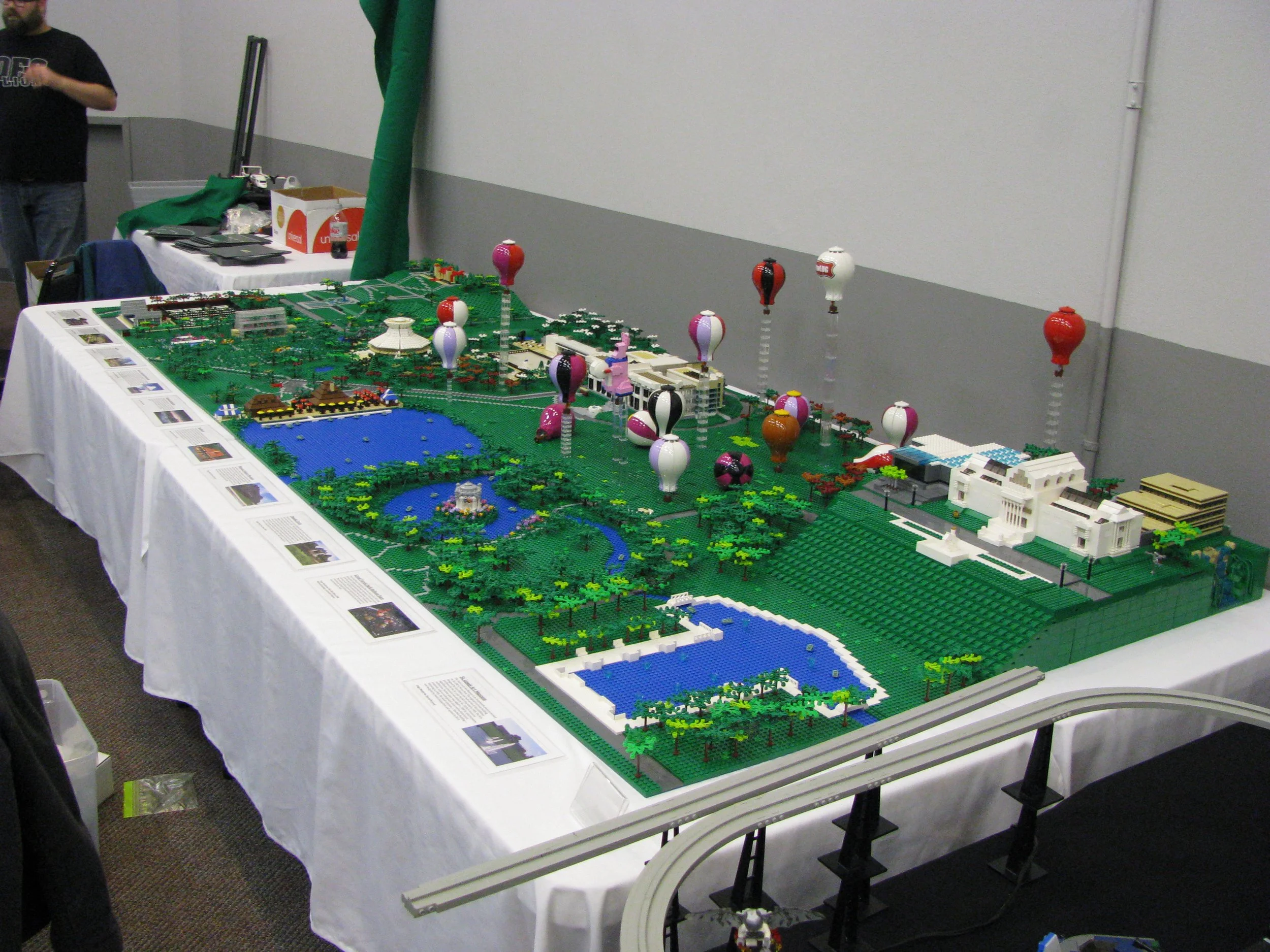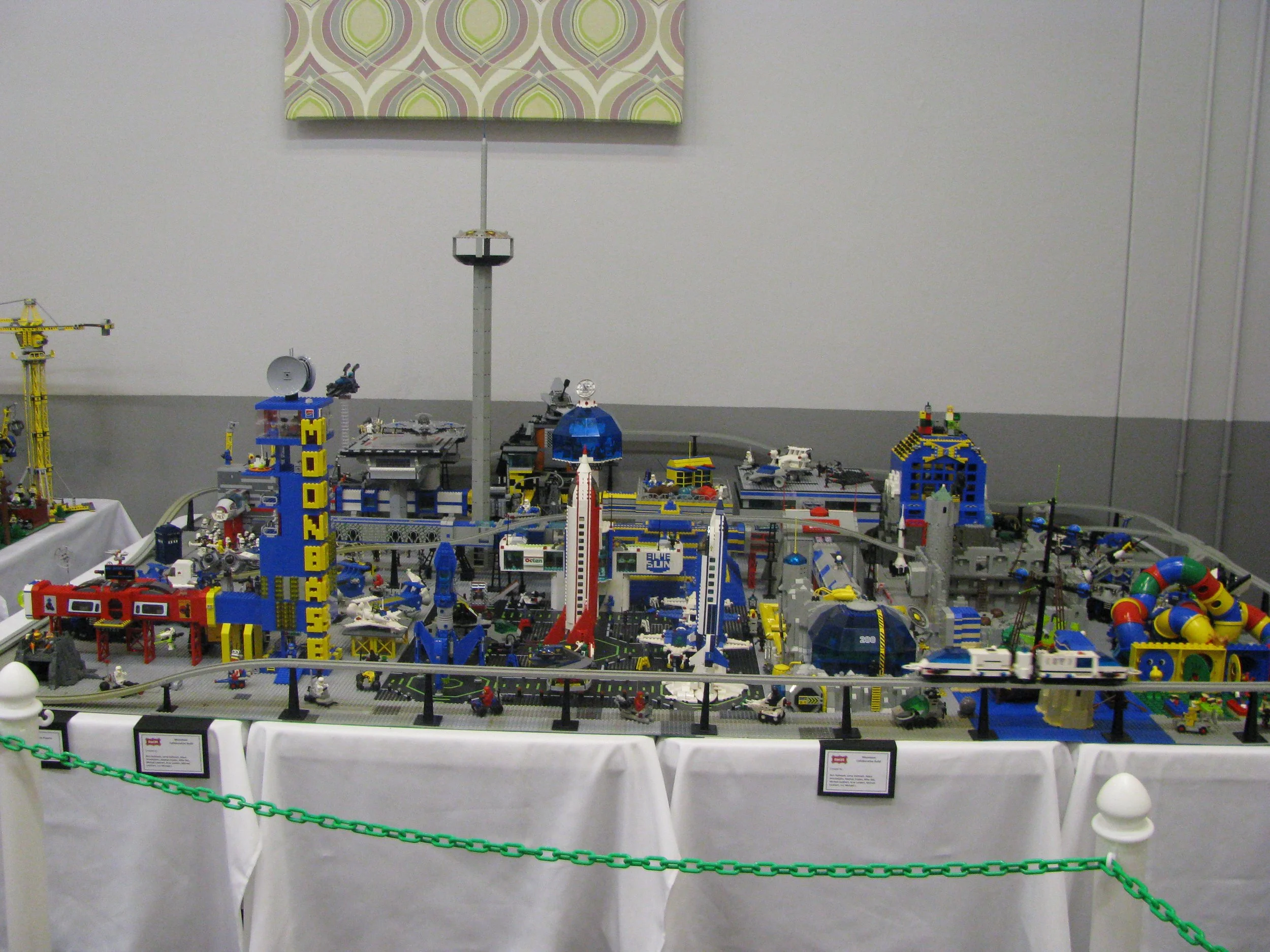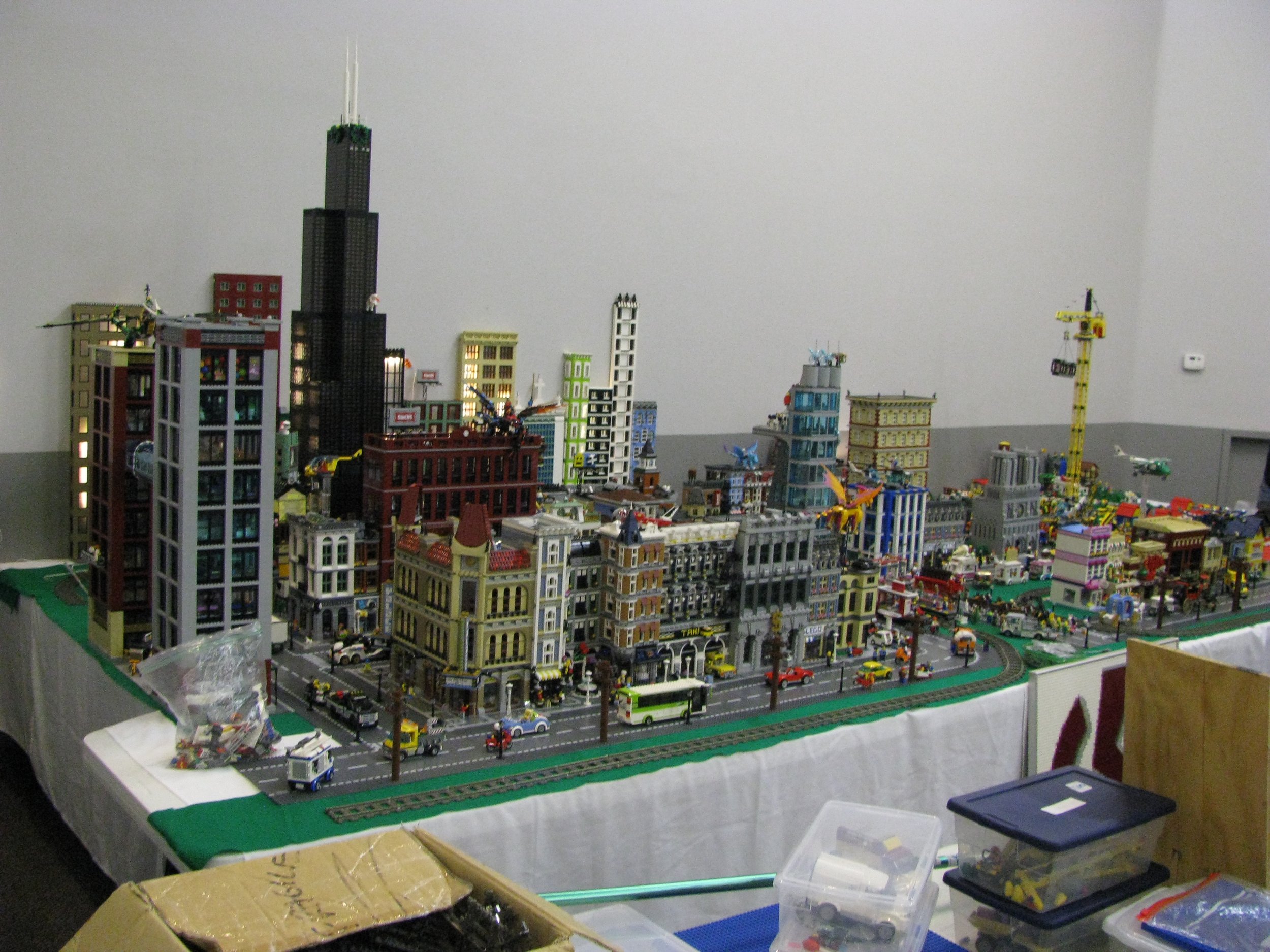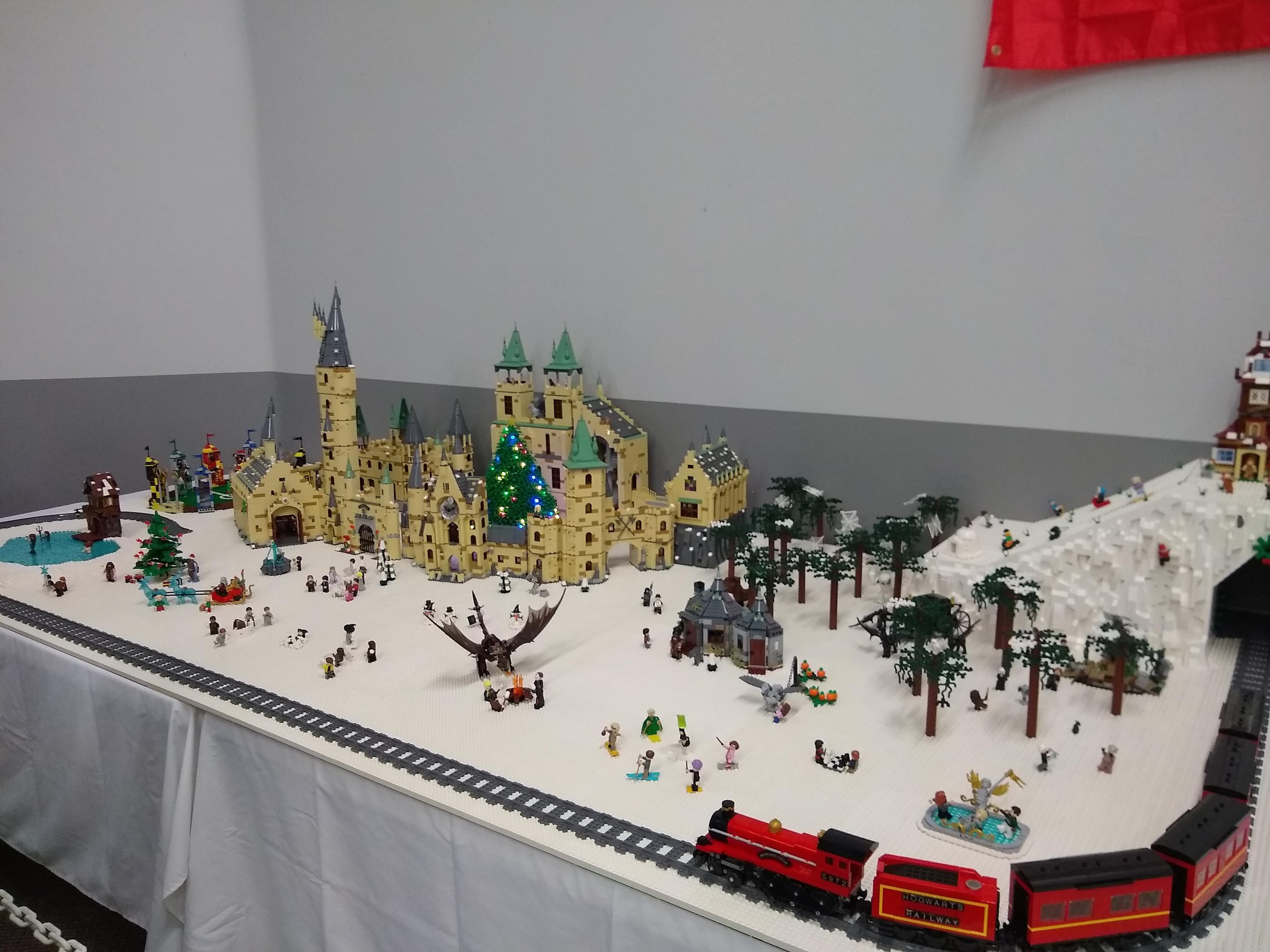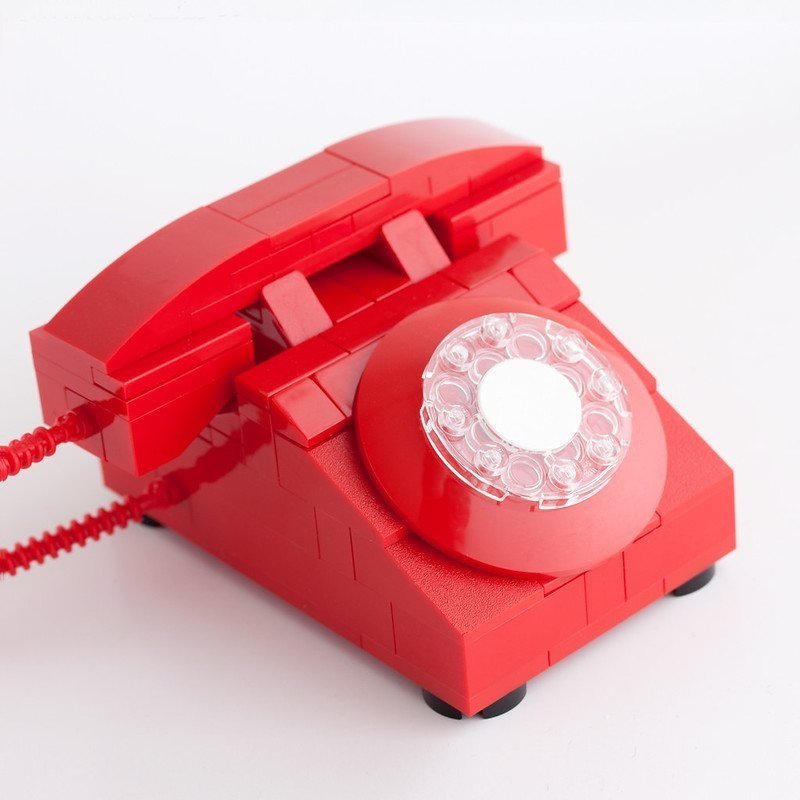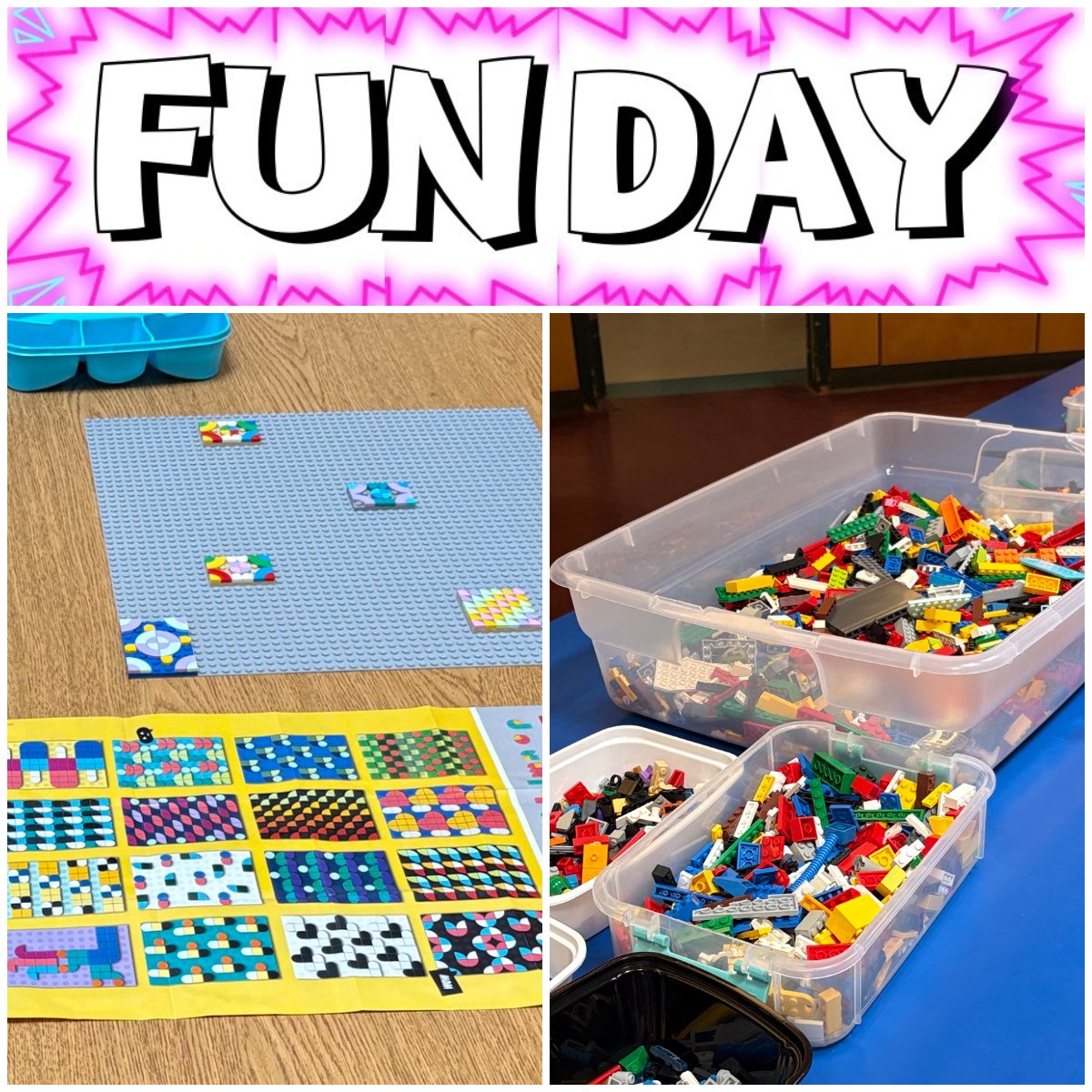How to Put on a Month-Long LEGO Display: Gateway LUG at the Way of Lights
/Many of us are familiar with large, short-term displays at fan conventions and other events. A great deal of planning goes into these collaborative displays, and coordinating a multitude of them at the big conventions is a massive challenge. But what does it take to put on a large, long-term display? Gateway LEGO Users Group (GtwLUG), based in Saint Louis Missouri, has been running a month-long display every year since 2015 (excluding 2020, but we’re back this year). The National Shrine of Our Lady of the Snows has held the annual Way of Lights Christmas light display for 52 years now.
In the early 2000s, the Shrine (as LUG members abbreviate it) approached GtwLUG about a LEGO display. At the time the LUG was significantly smaller and was unable to participate. However, a deal was worked with a LUG in Ohio to supply the bricks, and GtwLUG would provide support. After a few years, the transportation of bricks across two states every winter got old, and the LEGO show went away.
Aerial view of the 2021 City during set up, the city takes about two weeks to get to this point.
In 2015 the Shrine came back to GtwLUG and we decided that we had grown enough to attempt the show on our own. I had just joined at the time and was in my final semester of grad school. I wasn’t able to fully participate in that first show, but it was far different from what it is today. The LUG has grown quite a bit since then, and so have our displays. Today, we’re going to talk with David Warner and Mike Sita, the two head cat wranglers for this event to talk about what it takes to pull it off: a 2,000+ square foot (186 m2) LEGO display for a whole month each year!
Michael J: Mike and David, I’ve known both of you for about six years now—you both joined GtwLUG a little after I did. Would you mind sharing just a little bit of your LEGO history?
David: Like a lot of AFOLs, I played with LEGO sets as a kid, but only really got back into things as an adult maybe ten years ago. My introduction back to LEGO was the Architecture line. I remember visiting the Way of Lights the first year the club put on the display as a paid guest, and I think I joined the club at the February meeting following that. Since then I’ve really been ramping up my MOC building, and have also taken on larger and larger responsibilities for this show.
Mike Sita’s Construction Scene from 2016.
Mike: I, unlike most AFOLs, only had a couple LEGO sets when I was a kid, and LEGO wasn’t really all that important to me. I discovered my love for LEGO through my children. I guess about six or seven years ago when my oldest was in kindergarten, he had mentioned he wanted some LEGO like he played with at school. So I bought a couple sets for Christmas and randomly decided to let him have one early. We built it together, and we were hooked! By the time Christmas rolled around, we had already built those initial sets I bought for Christmas and then some. I stumbled upon GtwLUG almost immediately upon discovering my love for LEGO and contributed to the first Shrine display. I didn't step into my current role till year three at the Shrine. Year one is embarrassing, looking back; year two I did my own little two table city construction display; and since year three it's really just grown every year into something completely awesome!
The early days the City in 2016 (Year 2)
Michael J: So to the best of our knowledge, our month-long show at Our Lady of the Snows is a bit of an outlier for what most LUGs do. From my vantage point our planning, which you two spearhead (David the whole show and Mike the City display) is really key. The initial planning starts in June or July, and then things really start to move in August as we finalize the list of displays. Then we start getting ready for set-up in November. Can you give us some insight into that process?
David: The division of labor between me and Mike is mainly that I’m in charge of figuring out everything that people are contributing to the display—whether that’s an entire display for the show or just buildings for the city that we set up as part of the display—while Mike focuses on how to make all of those things fit into the available space. So I deal a lot with Google forms and sheets, answering questions from club members, and otherwise just trying to build out a list of things people have told us so that we have one source of the truth on all that.
Beyond that, a lot of time, especially this year as we’re in a new space, goes into coordinating with the staff running the Way of Lights, dealing with club members' concerns, and making sure we have all the supplies available to support the club when we start setting up. No one should take this on if they aren’t in a position to spend hundreds of hours on it as a bunch of small things quickly can consume a lot of time.
Portions of Saint Louis’ Forest Park at 1:300th scale. Both David and I have models in this collaboration from 2017
In terms of the specifics of laying things out, Mike and I spent a lot of time measuring the room and he was able to turn that into a floorplan that we were able to use to figure out where all the tables would fit. Mike made the first draft of the layout and then I took over once we moved into the stage of presenting it to the club and making changes based on their feedback as he had moved on to city planning at that point.


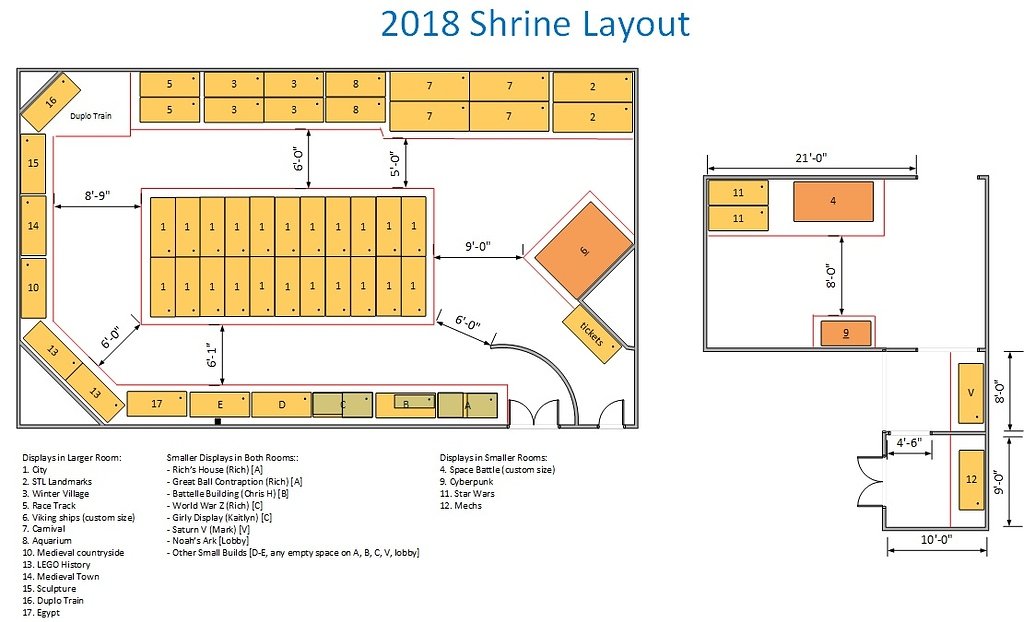
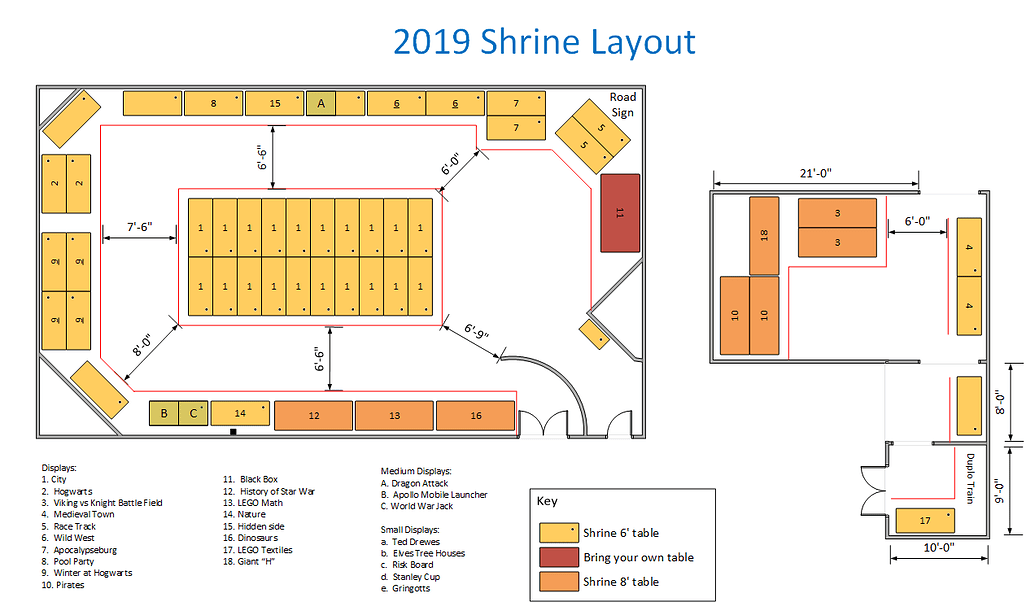

Mike: Well there's only two of us, and we drag along a couple other members for a lot of the setup (shout out to Adam S. for help with the city setup) but realistically this really should be a 4-5 person job. David and I really sacrifice a lot to make this happen. David more than me as my role is mostly enjoyable. The city alone has, I believe, 36 six-foot tables in it and there are something like 30 other displays of various sizes. Most of those displays are collaborations of 2-3 people max, if not just individual builders and club members showcasing their builds. David and I typically start with physically inspecting the display space, and taking measurements and notes. I sketch up the room in AutoCAD, and do some preliminary table layouts for individual displays, and then convert the main room floorplan to Sketchup and send it to David.
Once the club approves the table layout, I then take the list of city contributors David compiled and start plugging buildings into the layout on a baseplate grid (16x16, 16x32, 32x32 & 48x48 studs). I typically start doing this in AutoCAD, but at some point, once I have my general concept laid out, I switch to Microsoft Excel as that's easier to share with other club members. Then I just size the cells into a grid and start dropping in buildings thinking about sightlines and cool new build contributions I want to showcase. I start with major features and just plug and play until the list is empty. This is honestly the hardest part of the planning process for me. You also have to plan ahead because inevitably there will be some issues, a building overhangs too far or was incorrectly listed as a 32x32 building instead of a 16x32.

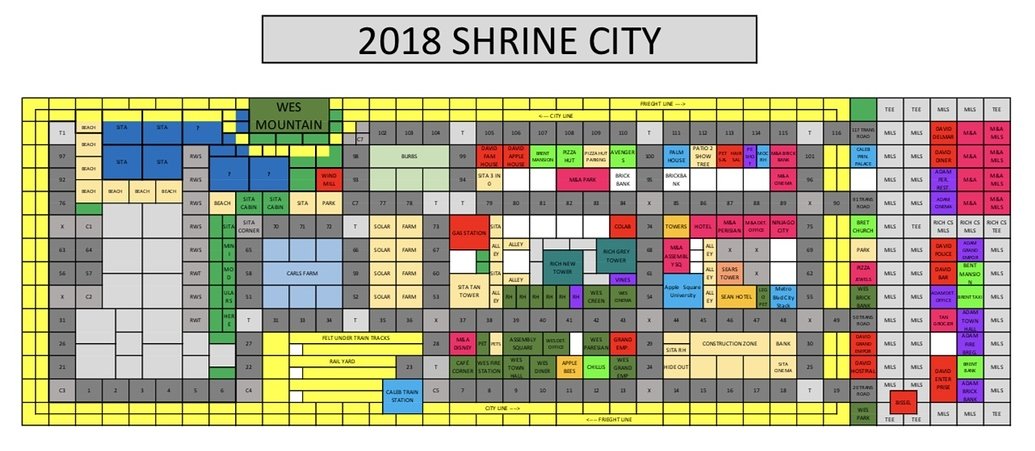
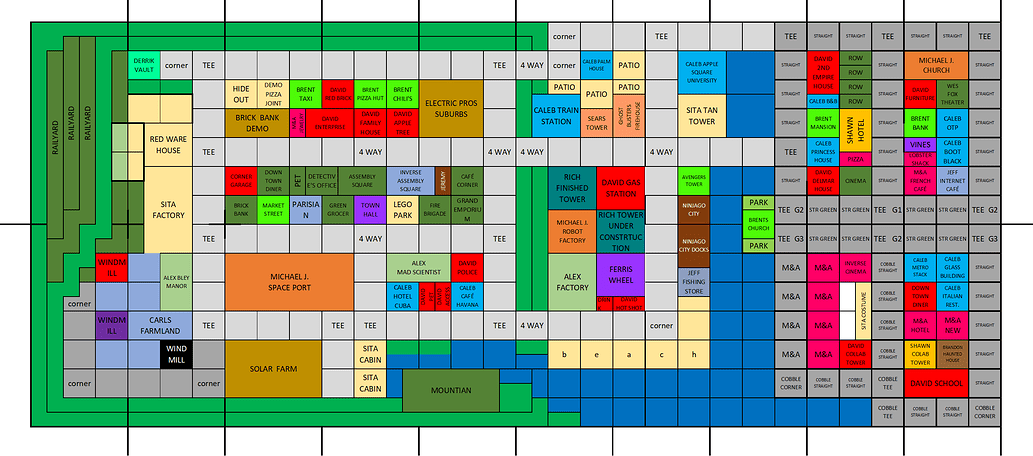
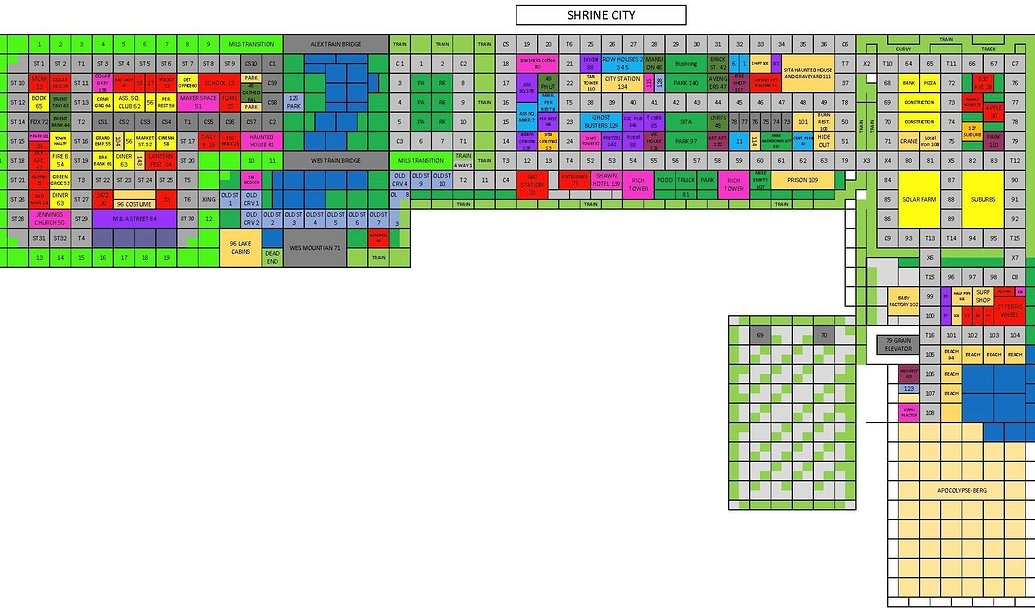
A show like this for one club to put on would otherwise be impossible if it weren’t for the length of the show, and people like David who do all the boring stuff to make this happen. We had three weeks to set up the city, whereas you may only have hours for a standard con or display. That fact alone allows us to make this event and the city so much better than we could at any other event. I don’t think this city could be set up in less than a week, which is longer than most other LEGO events.
City 2018 - This is the year we started to slowly incorporate MILS bases into the city.
Michael J: You two do take on basically another job for the back half of the year doing this! You both do fantastic work! Other than planning long-term displays we have unique challenges too. We’ve really focused on lighting the city, which is massive this year, and we played with motion a lot in 2018 and 2019. This year during set up it looks like the motion is a bit scaled back, but I may have missed some things. What are some of the memorable challenges that you remember, and how did we overcome them, or not in some cases?
Mike: Well, the city has more trains than ever, and two pretty impressive bridges and a functional windmill, but motion overall reliability is an ongoing issue because LEGO Power Functions unfortunately just don’t seem to hold up to daily abuse, being in constant use for 5-7 hours a day for 30 days straight. At that level of usage, even the official LEGO builds just seem to work themselves apart and fail over time. The only thing that has really been able to handle the abuse is the LEGO 9V train system with the metal track, though we have burned up a few train motors, as well, over the years.
City from 2018, successful movement 9V trains, and windmills, unsuccessful Set 10261 Roller Coaster was not designed for long term operations! It’s way in the background do you see it?
There has been talk of members trying different things in the future, but I think with the pandemic and the uncertainty of this year's event happening, most people just built what they wanted, and didn’t really put too much thought into motion this year. Also because of the pandemic, some of our members who were more versed in motion had to step back a bit, but that made room for other club members to shine in other ways!
One of our members, Jeff K., is not only a major contributor to the city but he has a pretty impressive medieval castle display that has some motion, and the same for Adam S.’s race track that uses 9V train motors that have been built up into race cars! So there's still quite a bit of motion! And there's Jeremy S.’s display that isn’t motorized but it includes every Minecraft set released combined into one display. So that's sure to be a crowd-pleaser with the kids!
David: As Mike said, figuring out how to make things move is a different challenge than figuring out how to keep them moving during a month-long installation. We have lots of club members who are good at the former, but we’re all still trying to figure out the latter. I’m really hopeful that a new technique that Megan is using this year in her Quidditch pitch display will pan out. Very simply, she added a timer to her display so the motion only runs about half the time.
One way that this display is different from setting up your MOC at a convention, for example, is that while we have club members present every night, we don’t have the actual builders of every display there every night. So the motion really needs to be turnkey in its operation. I always encourage folks who are thinking about adding motion to their displays to make sure they run them for a number of hours before they declare them ready for this show. Something that works just fine for an hour tends to find a way to shake itself apart during hour four or five. I remember two years ago when Chris H. built a very cool tower MOC with a dragon that circled the tower. I was glad I was there on the first night we were open, because the motion didn’t survive to night two, and the way it was built made it next to impossible to try to fix during an active event.
Moonbase! from 2016. A monorail in good condition makes for great motion too as long as the battery doesn’t die at the back of the display!
Michael J: I remember Chris H.’s dragon tower! I tried to help him strengthen it, but it would have needed a lot of internal structure added. I also remember the attempt at a small Great Ball Contraption. We spent more time unplugging it to cool down than actually running it. I had a few that were definitely in that self-destructive category! Testing and simple mechanisms are key for long-term movement.
City 2017 under construction!
This year has been rough with coming back from the pandemic, with its lingering concerns, and adjusting to a new space. Now that the show is up and running, what are you most looking forward to?
Mike: Taking a break! Lol There's a LOT of work put into this event on top of everyday life. I would hate to estimate the amount of time I put into this year's event and city. Easily over 200 hours. All the planning, the trips to the venue, talking to other club members, coordinating their builds, getting details on them, building everything for it, dealing with all the headaches that come with coordinating events like this, just the amount of time dedicated to city setup. I also designed and built several things specifically for this year's display as well prior to all this. I wanted to include my personal builds in the shrine I started all the way back in April. It's a lot.
A part of the 2017 City in the finished state. (shamelessly stolen for GtwLUG.org!)
So once I catch my breath from the marathon that is making it to opening night at the shrine, I really do enjoy working a shift at the display and talking to people about the display, the builds, and the club. Seeing kids' faces light up and adults turn back into kids looking at your hard work is really what makes it worth it. At home, I am going to spend a little extra time building with my three kids and take advantage of the majority of my LEGO being out of my LEGO space for a month and organize and clean what's left at home—and probably start to plan out or next LEGO city display for NMRA.
David: I’m looking forward to showing off our display to friends and family and actually being able to spend time building MOCs. Putting on a show like this is so time-consuming that you don’t really have time to do the things that got you into the hobby in the first place, but the end result is something I’m really proud of.
Michael J: I do love seeing the kids and sometimes the adults picking their jaw up off the floor when entering the display. It’s a lot of fun! It really is a unique way to share our hobby with others.
Winter at Hogwarts 2019
Michael J: Thanks for sharing some of the effort that goes into a display like this. Is there anything either of you would like to add? Where can our readers follow you online?
David: I’m @hiddeninput on Instagram.
Mike: @Dad_Reputation on Instagram. And you can follow GtwLUG as @gtwlug on Instagram, Facebook, and Flickr.
Michael J: Thank you! I knew you two handled quite a lot in making our LUG look so good every year, but it’s even more than I thought!
If you happen to be in Saint Louis, passing through Saint Louis, or even live within a reasonable driving distance of Saint Louis, come by and check out the display. I’ve talked to families who drive several hours every year to see the lights and our display.
David (on right) , other GtwLUG members, and I (on ladder) setting up for the 2021 display
The Shrine of Our Lady of the Snows is located just east of the I-255 / Illinois Highway 15 interchange in Belleville IL about 15 minutes east of Downtown Saint Louis. The display is in the main Visitors’ Center this year (there are signs) and there is a small fee for entrance ($5 per person). The display is open from 5 pm to 9 pm every night except on Christmas Eve and Christmas, ending on New Year’s Eve. (We even got some local news coverage this week!)
Have you been a part of a large collaborative display? Have you been to St. Louis to see the Way of Lights? Leave your thoughts in the comments below.
Do you want to help BrickNerd continue publishing articles like this one? Become a top patron like Charlie Stephens, Marc & Liz Puleo, Paige Mueller, Rob Klingberg from Brickstuff, John & Joshua Hanlon from Beyond the Brick, and Megan Lum to show your support, get early access, exclusive swag and more.


